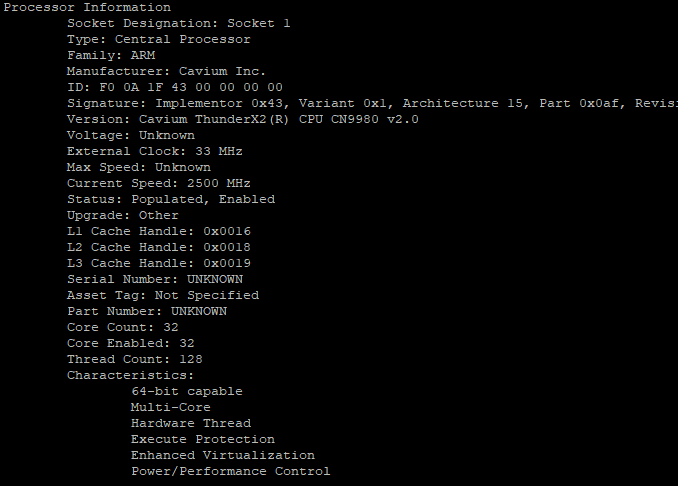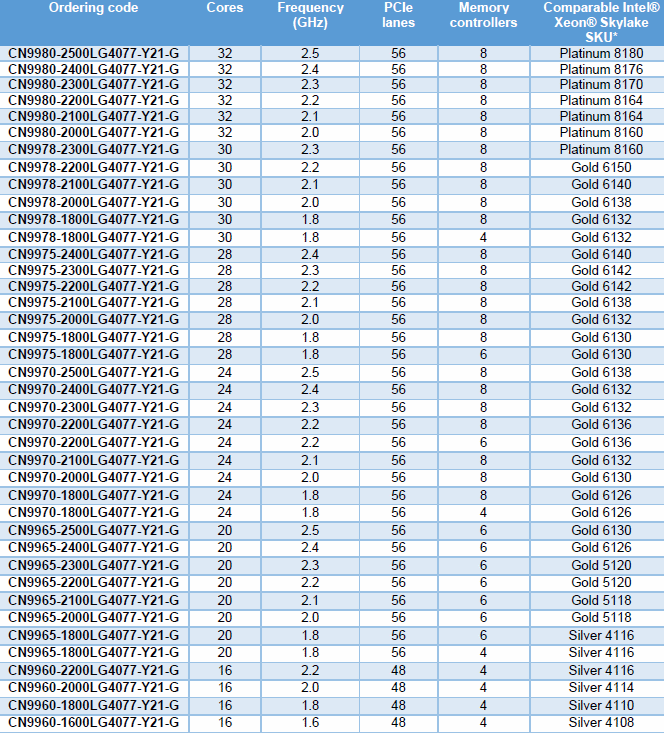Assessing Cavium's ThunderX2: The Arm Server Dream Realized At Last
by Johan De Gelas on May 23, 2018 9:00 AM EST- Posted in
- CPUs
- Arm
- Enterprise
- SoCs
- Enterprise CPUs
- ARMv8
- Cavium
- ThunderX
- ThunderX2
The ThunderX2 SKUs: 16 to 32 Cores
The SKU inside our test system was the ThunderX2 CN9980 2.2. This is the top SKU that is available right now, offering 32 cores at 2.2 GHz, which are able to further boost to 2.5 GHz.
According to Cavium's plans, many more SKUs will be available in the coming months. Cavium claims that a CN9980 at 2.5 GHz will be available soon, which would be capable of boosting to 3 GHz.
Cavium has listed all of their planned SKUs together alongside the comparable Intel SKU. By Cavium's definition, a comparable Intel SKU is a chip that achieves the same SPECInRate (2017) under gcc as Cavium's SKU.
As you can see, Cavium considers our CN9880 2.2 to be comparable to the much more expensive 8164. For our testing we will compare it to the 8176, as that was the Intel SKU available to us. Not that it should matter much: the 8176 only has a 3% higher clockspeed and 2 additional cores (+7%) over the 8164. Note however that if Cavium's ThunderX2 can really compete with these Intel SKUs, they are offering the same performance at one third of the cost of the Intel SKUs.












97 Comments
View All Comments
name99 - Thursday, May 24, 2018 - link
For crying out loud!At the very least, if you want to pursue this obsession regarding vectors, look at ARM's SVE (Scalable Vector Extensions). THAT is where ARM is headed in the vector space.
Fujitsu is implementing these for the cores of its next HPC machines, and they will likely roll out into other ARM cores (maybe Apple first? but who can be sure?) over the next few years.
To the extent that Cavium has any interest in competing in HPC, if/when they choose to do so it will be on the basis of an SVE implementation, not on the basis of NEON.
Meanwhile ARMv8 NEON is very much the equivalent of SSE. Not AVX, no, but SSE (in all its versions) yes.
tuxRoller - Thursday, May 24, 2018 - link
Nice comment.BTW, centriq (rip) only supports(ed) aarch64. I've no idea how much die space that saved, though.
Wilco1 - Thursday, May 24, 2018 - link
There is Cortex-A35, smallest AArch64 core so far with FP and Neon.However there are still big differences between RISC and CISC. For example it's not feasible for CISC to get anywhere near the same size/perf/power. The mobile Atom debacle has clearly shown it's not feasible to match small and efficient RISCs even with a better process and many billions of dollars...
peevee - Thursday, May 24, 2018 - link
It is not 8.2.lmcd - Wednesday, January 23, 2019 - link
Necro but worth for historic reasons: A35 is AArch32 but ARMv8ZolaIII - Thursday, May 24, 2018 - link
It would took them a same. AVX is a SIMD FP extension to the prime architectural instruction set same as NEON and cetera. The strict difference between CISC and RISC architecture is long gone and today's one's are combined & further more implement IVIL SIMDs and more & more of DSP components as MAC's. The train only starts on prime integer instruction set (where by the way ARM is stellar) and then switches it's worker's to FP extensions and accelerated blocks of different kinds. The same way lintel grow up AVX to 512 bit in current use NEON can be scaled up & beyond. Fuitsu worked with ARM on 1024 & 2048 NEON SIMD blocks couple of years ago. Still if you think how FP is a best way to do it you are wrong, DSP's use CP and it's much more efficient power & performance wise but less scalable.On what would you like server's to be compared? Almost 90% of enterprise servers run on Linux, even Microsoft is earning more money this day's on Linux than from selling Windows desktop & server's combined.
You are very ignorant person. Why do you coment about the things you don't know anything about?
Ryan Smith - Thursday, May 24, 2018 - link
"I really think Anandtech needs to branch into different websites. Its very strange and unappealing to certain users to have business/consumer/random reviews/phone info all bunched together."Although I appreciate the feedback, I must admit that we enjoy doing a variety of things. There are a lot of cool things happening in the technology world, not all of which are in the consumer space. So rare articles like these - and we only publish a few a year - let us keep tabs on what's going on in some of those other markets.
HStewart - Wednesday, May 23, 2018 - link
I would think that a lot of this depends what type of applications are running on server. Highly mathematical and especially any with Vectors will be likely different. Also there is no support for Windows based servers which limits which applications can be done - so my guess this will be useless if desiring a VMWave server.But it is interesting that it takes a 4SMT to compete with x86 based servers from Intel and AMD and with more cores 32 vs 22/28 depending on version.
Wilco1 - Wednesday, May 23, 2018 - link
You're right, on floating point and vectors the results are different. To be precise - even more impressive. See the last page for example where it soundly beats Skylake on OpenFoam and a few other HPC benchmarks. Hence the huge interest from all the HPC companies.Note Windows has been running on Arm for quite some time. Microsoft runs Windows Server both on Centriq and ThunderX2. See eg. https://www.youtube.com/watch?v=uF1B5FfFLSA for more info.
HStewart - Wednesday, May 23, 2018 - link
Windows on ARM is DOA,